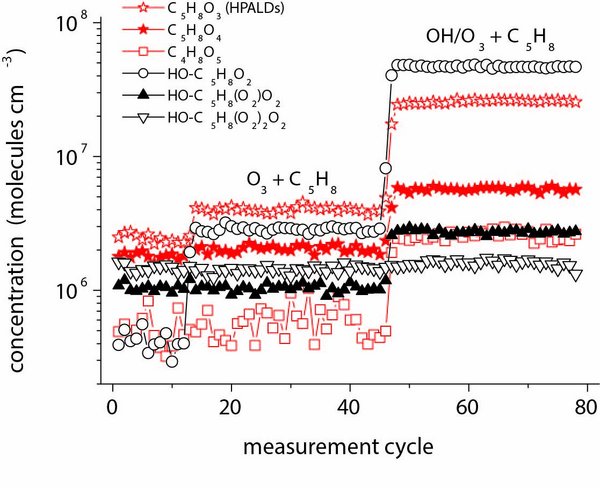Mechanistic and kinetic investigations in the laboratory are carried out in the field of atmospherically relevant gas-phase reactions of OH radicals as well as for ozonolysis reactions. The studies are focused on a detailed understanding of the degradation mechanisms. Special attention is drawn to unimolecular and bimolecular reactions of RO2 radicals, which represent the reactive intermediates in the course of the oxidation process.
The investigations are tightly connected with the further development of mass spectrometric detection techniques for reactive intermediates and closed-shell products with high sensitivity.
Findings of recent investigations describe the formation of highly oxidized RO2 radicals HO-C10H16(O2)2O2 from the reaction of OH radicals with ∝-pinene (Berndt et al. 2016), the formation of accretion products via RO2 + R´O2 → ROOR´ + O2 (Berndt et al. 2018) and the formation of the early products from the reaction of OH radicals with isoprene (Berndt et al. 2019).
References:
Berndt T., Richters S., Jokinen T., Hyttinen N., Kurtén T., Otkjær R. V., Kjaergaard H. G., Stratmann F., Herrmann H., Sipilä M., Kulmala M., Ehn M. (2016) Hydroxyl radical-induced formation of highly oxidized organic compounds. Nature Communications 7:13677, 8 pp., doi: 10.1038/ncomms13677.
Berndt T., Scholz W., Mentler B., Fischer L., Herrmann H., Kulmala M., Hansel A. (2018) Accretion Product Formation from Self- and Cross-Reactions of RO2 Radicals in the Atmosphere. Angewandte Chemie International Edition 57 (14), 3820-3824, doi: doi:10.1002/anie.201710989.
Berndt T., Hyttinen N., Herrmann H., Hansel A. (2019) First oxidation products from the reaction of hydroxyl radicals with isoprene for pristine environmental conditions. Communications Chemistry 2 (1), 21, doi: 10.1038/s42004-019-0120-9.

